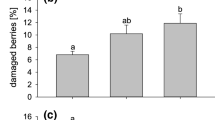Abstract
We have successfully reduced populations of economically damaging Pacific mites by introducing another economically unimportant herbivorous mite to grapevines. Although this technique has proven successful in greenhouse and commercial applications, we had a poor understanding of why it worked. Experiments were conducted in a Zinfandel vineyard to assess the relative importance of different forms of competition between these two species and the importance of the timing of the introduction. The early season release of Willamette mites that occurred as shoots were first elongating reduced populations of Pacific mites, indicating that some form of competition occurred in this experiment. However, introductions of Willamette mites 4 weeks later did not reduce populations of Pacific mites. An early season release is essential for control. Control shoots did not receive additions of Willamette mites and had high population densities of Pacific mites. In contrast to this, Pacific mite populations were reduced on treatments with Willamette mites, regardless of whether the two species overlapped spatially or were separated by a barrier. This indicated that physical interference was not responsible, that induced resistance was involved, and that the effect was systemic throughout the shoot.
Similar content being viewed by others
References
English-Loeb GM, Karban R (1988) Negative interactions between Willamette mites and Pacific mites: possible management strategies for grapes. Entomologia Exp Appl 48:269–274
English-Loeb GM, Karban R, Hougen-Eitzman D (1993) Relative importance of direct and indirect competition in mediating negative interactions between Willamette mites and Pacific mites on grapes. Ecol Appl 3:699–707
Flaherty DL, Huffaker CB (1970) Biological control of Pacific mites and Willamette mites in San Joaquin valley vineyards. I. The role of Metaseilus occidentalis. Hilgardia 40:267–308
Flaherty DL, Hoy MA, Lynn CD, Peacock WL (1981) Spider mites. In: Flaherty DL, Jenson FL, Kasimatis AN, Kido H, Moller WL (eds) Grape pest management. Agricultural Science Publications, Berkeley, pp 111–125
Karban R, English-Loeb GM (1988) Effects of herbivory and plant conditioning on the population dynamics of spider mites. Exp Appl Acarol 4:225–246
Karban R, English-Loeb GM (1990) A “vaccination” of Willamette spider mites (Acari:Tetranychidae) to prevent large populations of Pacific spider mites on grapevines. J Econ Entom 83:2252–2257
Karban R, Hougen-Eitzman D, English-Loeb GM (1994) Predator-mediated apparent competition between two herbivores that feed on grapevines. Oecologia 97:508–511
McKey D (1974) Adaptive patterns in alkaloid physiology. Am Nat 108:305–320
Quinn JF, Dunham AE (1983) On hypothesis testing in ecology and evolution. Am Nat 122:602–617
Rhoades DF (1983) Herbivore population dynamics and plant chemistry. In: Denno RF, McClure MS (eds) Variable plants and herbivores in natural and managed systems. Academic Press, New York, pp 155–222
Schoener TW (1983) Field experiments on interspecific competition. Am Nat 122:240–285
Author information
Authors and Affiliations
Rights and permissions
About this article
Cite this article
Hougen-Eitzman, D., Karban, R. Mechanisms of interspecific competition that result in successful control of Pacific mites following inoculations of Willamette mites on grapevines. Oecologia 103, 157–161 (1995). https://doi.org/10.1007/BF00329075
Received:
Accepted:
Issue Date:
DOI: https://doi.org/10.1007/BF00329075




